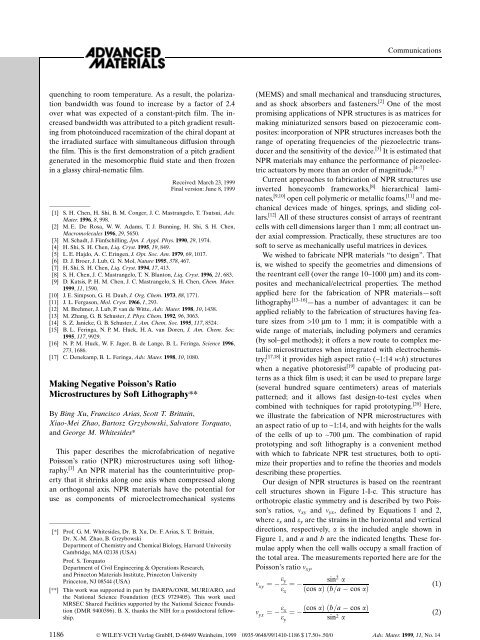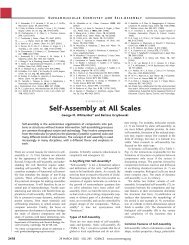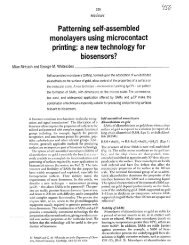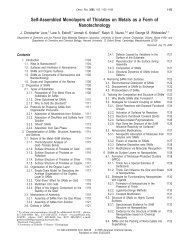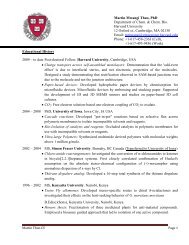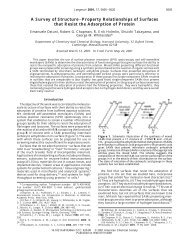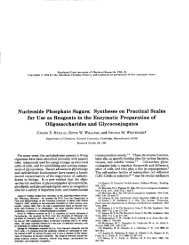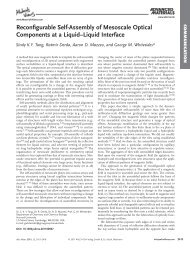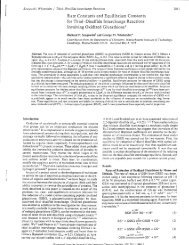Making Negative Poisson's Ratio Microstructures by Soft Lithography**
Making Negative Poisson's Ratio Microstructures by Soft Lithography**
Making Negative Poisson's Ratio Microstructures by Soft Lithography**
You also want an ePaper? Increase the reach of your titles
YUMPU automatically turns print PDFs into web optimized ePapers that Google loves.
quenching to room temperature. As a result, the polarization<br />
bandwidth was found to increase <strong>by</strong> a factor of 2.4<br />
over what was expected of a constant-pitch film. The increased<br />
bandwidth was attributed to a pitch gradient resulting<br />
from photoinduced racemization of the chiral dopant at<br />
the irradiated surface with simultaneous diffusion through<br />
the film. This is the first demonstration of a pitch gradient<br />
generated in the mesomorphic fluid state and then frozen<br />
in a glassy chiral-nematic film.<br />
Received: March 23, 1999<br />
Final version: June 8, 1999<br />
±<br />
[1] S. H. Chen, H. Shi, B. M. Conger, J. C. Mastrangelo, T. Tsutsui, Adv.<br />
Mater. 1996, 8, 998.<br />
[2] M. E. De Rosa, W. W. Adams, T. J. Bunning, H. Shi, S. H. Chen,<br />
Macromolecules 1996, 29, 5650.<br />
[3] M. Schadt, J. FuÈ nfschilling, Jpn. J. Appl. Phys. 1990, 29, 1974.<br />
[4] H. Shi, S. H. Chen, Liq. Cryst. 1995, 19, 849.<br />
[5] L. E. Hajdo, A. C. Eringen, J. Opt. Soc. Am. 1979, 69, 1017.<br />
[6] D. J. Broer, J. Lub, G. N. Mol, Nature 1995, 378, 467.<br />
[7] H. Shi, S. H. Chen, Liq. Cryst. 1994, 17, 413.<br />
[8] S. H. Chen, J. C. Mastrangelo, T. N. Blanton, Liq. Cryst. 1996,21, 683.<br />
[9] D. Katsis, P. H. M. Chen, J. C. Mastrangelo, S. H. Chen, Chem. Mater.<br />
1999, 11, 1590.<br />
[10] J. E. Simpson, G. H. Daub, J. Org. Chem. 1973, 88, 1771.<br />
[11] J. L. Fergason, Mol. Cryst. 1966, 1, 293.<br />
[12] M. Brehmer, J. Lub, P. van de Witte, Adv. Mater. 1998, 10, 1438.<br />
[13] M. Zhang, G. B. Schuster, J. Phys. Chem. 1992, 96, 3063.<br />
[14] S. Z. Janicke, G. B. Schuster, J. Am. Chem. Soc. 1995, 117, 8524.<br />
[15] B. L. Feringa, N. P. M. Huck, H. A. van Doren, J. Am. Chem. Soc.<br />
1995, 117, 9929.<br />
[16] N. P. M. Huck, W. F. Jager, B. de Lange, B. L. Feringa, Science 1996,<br />
273, 1686.<br />
[17] C. Denekamp, B. L. Feringa, Adv. Mater. 1998, 10, 1080.<br />
<strong>Making</strong> <strong>Negative</strong> <strong>Poisson's</strong> <strong>Ratio</strong><br />
<strong>Microstructures</strong> <strong>by</strong> <strong>Soft</strong> <strong>Lithography**</strong><br />
By Bing Xu, Francisco Arias, Scott T. Brittain,<br />
Xiao-Mei Zhao, Bartosz Grzybowski, Salvatore Torquato,<br />
and George M. Whitesides*<br />
This paper describes the microfabrication of negative<br />
<strong>Poisson's</strong> ratio (NPR) microstructures using soft lithography.<br />
[1] An NPR material has the counterintuitive property<br />
that it shrinks along one axis when compressed along<br />
an orthogonal axis. NPR materials have the potential for<br />
use as components of microelectromechanical systems<br />
±<br />
[*] Prof. G. M. Whitesides, Dr. B. Xu, Dr. F. Arias, S. T. Brittain,<br />
Dr. X.-M. Zhao, B. Grzybowski<br />
Department of Chemistry and Chemical Biology, Harvard University<br />
Cambridge, MA 02138 (USA)<br />
Prof. S. Torquato<br />
Department of Civil Engineering & Operations Research,<br />
and Princeton Materials Institute, Princeton University<br />
Princeton, NJ 08544 (USA)<br />
[**] This work was supported in part <strong>by</strong> DARPA/ONR, MURI/ARO, and<br />
the National Science Foundation (ECS 9729405). This work used<br />
MRSEC Shared Facilities supported <strong>by</strong> the National Science Foundation<br />
(DMR 9400396). B. X. thanks the NIH for a postdoctoral fellowship.<br />
Communications<br />
(MEMS) and small mechanical and transducing structures,<br />
and as shock absorbers and fasteners. [2] One of the most<br />
promising applications of NPR structures is as matrices for<br />
making miniaturized sensors based on piezoceramic composites:<br />
incorporation of NPR structures increases both the<br />
range of operating frequencies of the piezoelectric transducer<br />
and the sensitivity of the device. [3] It is estimated that<br />
NPR materials may enhance the performance of piezoelectric<br />
actuators <strong>by</strong> more than an order of magnitude. [4±7]<br />
Current approaches to fabrication of NPR structures use<br />
inverted honeycomb frameworks, [8] hierarchical laminates,<br />
[9,10] open cell polymeric or metallic foams, [11] and mechanical<br />
devices made of hinges, springs, and sliding collars.<br />
[12] All of these structures consist of arrays of reentrant<br />
cells with cell dimensions larger than 1 mm; all contract under<br />
axial compression. Practically, these structures are too<br />
soft to serve as mechanically useful matrices in devices.<br />
We wished to fabricate NPR materials ªto designº. That<br />
is, we wished to specify the geometries and dimensions of<br />
the reentrant cell (over the range 10±1000 mm) and its composites<br />
and mechanical/electrical properties. The method<br />
applied here for the fabrication of NPR materialsÐsoft<br />
lithography [13±16] Ðhas a number of advantages: it can be<br />
applied reliably to the fabrication of structures having feature<br />
sizes from >10 mm to 1 mm; it is compatible with a<br />
wide range of materials, including polymers and ceramics<br />
(<strong>by</strong> sol±gel methods); it offers a new route to complex metallic<br />
microstructures when integrated with electrochemistry;<br />
[17,18] it provides high aspect ratio (~1:14 w:h) structures<br />
when a negative photoresist [19] capable of producing patterns<br />
as a thick film is used; it can be used to prepare large<br />
(several hundred square centimeters) areas of materials<br />
patterned; and it allows fast design-to-test cycles when<br />
combined with techniques for rapid prototyping. [20] Here,<br />
we illustrate the fabrication of NPR microstructures with<br />
an aspect ratio of up to ~1:14, and with heights for the walls<br />
of the cells of up to ~700 mm. The combination of rapid<br />
prototyping and soft lithography is a convenient method<br />
with which to fabricate NPR test structures, both to optimize<br />
their properties and to refine the theories and models<br />
describing these properties.<br />
Our design of NPR structures is based on the reentrant<br />
cell structures shown in Figure 1-I-c. This structure has<br />
orthotropic elastic symmetry and is described <strong>by</strong> two <strong>Poisson's</strong><br />
ratios, nxy and nyx, defined <strong>by</strong> Equations 1 and 2,<br />
where ex and ey are the strains in the horizontal and vertical<br />
directions, respectively, a is the included angle shown in<br />
Figure 1, and a and b are the indicated lengths. These formulae<br />
apply when the cell walls occupy a small fraction of<br />
the total area. The measurements reported here are for the<br />
<strong>Poisson's</strong> ratio n xy.<br />
nxy ˆ ey ˆ<br />
ex nyx ˆ ex ˆ<br />
ey sin 2 a<br />
…cos a† …b=a cos a†<br />
…cos a† …b=a cos a†<br />
sin 2 a<br />
1186 Ó WILEY-VCH Verlag GmbH, D-69469 Weinheim, 1999 0935-9648/99/1410-1186 $ 17.50+.50/0 Adv. Mater. 1999, 11, No. 14<br />
(1)<br />
(2)
Communications<br />
<strong>Soft</strong> lithography offers an effective<br />
method to fabricate microstructures<br />
with tuned <strong>Poisson's</strong><br />
ratios, based on cells with designed<br />
shapes. Figure 1 shows a<br />
series of structures with different<br />
unit cells; we expected these<br />
structures to have different <strong>Poisson's</strong><br />
ratios. Structures A±F have<br />
NPR. Structures A [21] and B [9]<br />
have linear walls; structures C±F<br />
have curved walls that are intended<br />
to clarify the relationship<br />
between cell shape and the value<br />
of the <strong>Poisson's</strong> ratio. Structures<br />
G and H have positive <strong>Poisson's</strong><br />
ratio (PPR).<br />
Figure 2 illustrates the process<br />
used to fabricate NPR microstructures.<br />
An NPR pattern, designed<br />
with a computer-assisted<br />
design (CAD) program, was<br />
transferred into a transparent<br />
polymer film using a commercial<br />
high-resolution printer (Herkules<br />
PRO, 3387 dpi; Linotype-Hell<br />
Company). We used the transparency<br />
directly as a mask for contact<br />
photolithography to create a<br />
relief structure in negative thick<br />
photoresist (SU-8, MicroChem<br />
Corp., Newton, MA); these structures<br />
had aspect ratios of up to<br />
1:14 and heights of up to<br />
~600 mm.<br />
To fabricate polymeric or carbon<br />
NPR structures, we used<br />
three soft lithographic techniques:<br />
microtransfer molding<br />
(mTM), micromolding in capillaries<br />
(MIMIC), and microembossing.<br />
Each is compatible<br />
with a variety of polymers. We<br />
made stamps for the fabrication<br />
of polymeric NPR structures <strong>by</strong><br />
casting and curing polydimethylsiloxane<br />
(PDMS) against patterned<br />
SU-8 photoresist. When a<br />
PDMS mold was used in MIMIC,<br />
we made its thickness
ucts), when placed on the edge of the mold, filled the channels<br />
<strong>by</strong> capillarity. Exposure to UV light (450 W mediumpressure<br />
Hg vapor lamp) for 30 min cured the prepolymer<br />
in the filled mold. Figure 3a shows a polyurethane NPR<br />
structure made with MIMIC. Larger areas can be fabricated<br />
<strong>by</strong> assisting filling of the mold using vacuum. [22]<br />
Fig. 3. a,b,d±h) Scanning electron microscopy (SEM) images of NPR microstructures<br />
made of various materials: a) polyurethane (aspect ratio of 1:3,<br />
height of 325 mm); b) glassy carbon (1:6, 157 mm); d) PVDF (1:8, 420 mm);<br />
e) epoxy (1:15, 590 mm); f) epoxy (1:10, 260 mm); g) nickel (1:3, 210 mm); h)<br />
nickel (1:3, 260 mm). c) SEM image of a PPR microstructure made of PVDF<br />
with aspect ratio of 1:8 and height of 400 mm.<br />
Since the thermal stability and chemical inertness of carbon<br />
make it an attractive material as a component in<br />
MEMS, we also fabricated glassy carbon [23] NPR structures.<br />
We used mTM to mold furfuryl alcohol, a carbon precursor,<br />
and pyrolyzed the molded microstructure to form an NPR<br />
pyrolytic carbon structure (Fig. 3b).<br />
Microtransfer molding and MIMIC work only with liquid<br />
prepolymers. In order to apply soft lithography to thermoplastic<br />
polymers, we used microembossing, with the PDMS<br />
stamp as a pattern transfer element. Polyvinylene difluoride<br />
(PVDF) pellets (Aldrich, Mw = 180 000, Tm = 170 C)<br />
were heated above 250 C, compressed between a PDMS<br />
stamp and a glass slide with pressure (80 kPa), and then<br />
cooled to room temperature. After cooling, separation of<br />
the PVDF and the PDMS stamp yielded NPR structures<br />
(Fig. 3c and 3d).<br />
Communications<br />
The SU-8 photoresist becomes a cross-linked epoxy after<br />
exposure to UV light. It is therefore possible to make polymeric<br />
microstructures directly from SU-8. To create freestanding<br />
epoxy microstructures, we used PDMS as a sacrificial<br />
layer: [24] We spin-coated and cured a thin layer of<br />
PDMS on a silicon wafer, and spin-coated SU-8 on top of<br />
the PDMS. After exposure and development of SU-8, the<br />
PDMS film was dissolved in a solution of tetrabutyl ammonium<br />
fluoride (TBAF, 1.0 M in tetrahydrofuran, THF) to<br />
produce a freestanding SU-8 structure (Fig. 3e and 3f).<br />
We measured the <strong>Poisson's</strong> ratios of two representative<br />
structures (B and F, both structures fabricated in SU-8).<br />
The <strong>Poisson's</strong> ratio of structure B is described <strong>by</strong> Equation<br />
1, but no theoretical solution is available for structure<br />
F. We found that structure B has a <strong>Poisson's</strong> ratio of<br />
±1.08, while structure F has a <strong>Poisson's</strong> ratio of ±0.58<br />
(Fig. 4). The wavy ªstrutº in structure F is in part responsible<br />
for the lower absolute value of the <strong>Poisson's</strong> ratio.<br />
We also fabricated metallic NPR structures since, compared<br />
with polymers, metals have higher Young's moduli<br />
Fig. 4. Strain±strain plots for SU-8 NPR microstructures under load [26].<br />
Arrows indicate the directions, denoted <strong>by</strong> x, of applied loads; y refers to<br />
the in-plane direction orthogonal to x. a) Plot for a structure of the type in<br />
Figure 1-II-B. The dotted line indicates the strain±strain curve calculated<br />
from Equation 1. b) Plot for a structure of the type in Figure 1-II-F.<br />
1188 Ó WILEY-VCH Verlag GmbH, D-69469 Weinheim, 1999 0935-9648/99/1410-1188 $ 17.50+.50/0 Adv. Mater. 1999, 11, No. 14
Communications<br />
(and can therefore withstand higher tensile loads) and are<br />
more stable against heat and oxidation. To fabricate NPR<br />
structures made of nickel, we electroplated nickel through<br />
SU-8 photoresist that was patterned on a gold-coated<br />
(200 nm thick) wafer. Figure 3g and 3h show nickel NPR<br />
structures with height of ~300 mm and area of ~50 cm 2 .<br />
Most of our work concerns planar NPR structures, but<br />
three-dimensional (3D) NPR structures are required for<br />
some applications. Figure 5-I illustrates the process we<br />
used to make a 3D NPR structure. First, we made a PDMS<br />
membrane [25] that has a NPR pattern. Second, the PDMS<br />
membrane was coated with gold <strong>by</strong> thermal evaporation<br />
and wrapped around a glass cylinder; care was taken to<br />
align the two ends of the membrane. Third, nickel was electroplated<br />
on the gold layer. Finally, a freestanding, metallic<br />
NPR structure was obtained <strong>by</strong> dissolving the PDMS using<br />
TBAF and removing the cylinder. It is straightforward to<br />
extend this approach to other 3D NPR structures.<br />
Fig. 5. I. Schematic representation (a) of the process used to fabricate 3D<br />
NPR materials: Electrodeposition on a gold-coated PDMS membrane (b)<br />
wrapped around a glass cylinder yields a nickel tube with an NPR wall (c).<br />
II. A nickel structure (a) of the design (b) composed of both PPR and NPR<br />
structures.<br />
We have demonstrated that soft lithography is a useful<br />
technique for making NPR structures having features with<br />
cell sizes of 100±500 mm, wall thicknesses of 25±100 mm,<br />
and aspect ratios of up to 1:14. The combination of rapid<br />
prototyping and soft lithography makes it possible to prepare<br />
planar and 3D structures with a broad range of <strong>Poisson's</strong><br />
ratios. An example of a structure that integrates NPR<br />
and PPR structures into a designed system is shown in Fig-<br />
ure 5-II. This structure is designed to convert a stress into a<br />
tilt (Fig. 5-II-A); Figure 5-II-B shows this structure fabricated<br />
in nickel.<br />
The ability of these techniques to accept a range of different<br />
materialsÐpolymers, metals, and ceramicsÐoffers<br />
the opportunity to combine materials with different <strong>Poisson's</strong><br />
ratios (as well as different physical properties) with<br />
different structures.<br />
Received: February 19, 1999<br />
Final version: June 1, 1999<br />
±<br />
[1] Y. Xia, G. M. Whitesides, Angew. Chem. Int. Ed. 1998, 37, 550.<br />
[2] J. B. Choi, R. S. Lakes, Cell. Polym. 1991, 10, 205.<br />
[3] P. C. Y. Lee, J. Appl. Phys. 1971, 42, 4139.<br />
[4] W. A. Smith, IEEE Trans. Ultrason. Ferroelect. Freq. Control 1993, 40,<br />
41.<br />
[5] M. J. Haun, R. E. Newnham, Ferroelectrics 1986, 68, 123.<br />
[6] H. L. W. Chan, J. Unsworth, IEEE Trans. Ultrason. Ferroelect. Freq.<br />
Control 1989, 36, 434.<br />
[7] L. .V Gibiansky, S. Torquato, J. Mech. Phys. Solids 1997, 44, 233.<br />
[8] A. G. Kolpakov, J. Appl. Mech. USSR 1985, 49, 739.<br />
[9] G. W. Milton, J. Mech. Phys. Solids 1992, 40, 1105.<br />
[10] L. J. Gibson, M. Ash<strong>by</strong>, Cellular Solids, 2nd ed., Pergamon, Oxford<br />
1997.<br />
[11] R. S. Lakes, Science 1987, 235, 1038.<br />
[12] R. F. Almgren, J. Elasticity 1985, 15, 427.<br />
[13] X.-M. Zhao, Y. Xia, G. M. Whitesides, J. Mater. Chem. 1997, 7, 1069.<br />
[14] Y. Xia, G. M. Whitesides, Annu. Rev. Mater. Sci. 1998, 28, 153.<br />
[15] S. T. Brittain, K. Paul, X.-M. Zhao, G. M. Whitesides, Phys. World<br />
1998, 11, 31.<br />
[16] D. Qin, Y. Xia, J. A. Rogers, R. J. Jackman, X.-M. Zhao, G. M. Whitesides,<br />
in Microsystem Technology in Chemistry and Life Sciences,<br />
Vol. 194 (Eds: A. Manz, H. Becker), Springer, Berlin 1998, p.1.<br />
[17] R. J. Jackman, S. T. Brittain, A. Adams, M. G. Prentiss, G. M. Whitesides,<br />
Science 1998, 280, 2089.<br />
[18] R. J. Jackman, G. M. Whitesides, Chemtech 1999, 5, 18.<br />
[19] J. M. Shaw, J. D. Gelorme, N. C. Labianca, W. E. Conley, S. J. Holmes,<br />
IBM J. Res. Dev. 1997, 41, 81.<br />
[20] D. Qin, Y. Xia, G. M. Whitesides, Adv. Mater. 1996, 8, 917.<br />
[21] O. Sigmund, in Proc. 3rd Int. Conf. on Intelligent Materials, Proc. SPIE,<br />
Vol. 2779 (Ed: P. Gobin), SPIE, Bellingham, WA 1996.<br />
[22] N. L. Jeon, I. S. Choi, B. Xu, G. M. Whitesides, Adv. Mater. 1999, 11<br />
946.<br />
[23] O. J. A. Schueller, S. T. Brittain, C. Marzolin, G. M. Whitesides, Chem.<br />
Mater. 1997, 9, 1399.<br />
[24] B. Xu, F. Arias, G. M. Whitesides, Adv. Mater. 1999, 11, 492.<br />
[25] R. J. Jackman, D. C. Duffy, O. Cherniavskaya, G. M. Whitesides,<br />
Langmuir 1999, 15, 2973.<br />
[26] Due to the resolution of the experimental setup, our strain±strain<br />
curves do not pass through the (0,0) point exactly; this may be the<br />
reason for the difference between the calculated Possion's ratio and<br />
measured one (for structure Fig. 1-II-B): nxy(calc) = ±1.40, nxy(exp) =<br />
~1.08.<br />
_______________________<br />
Adv. Mater. 1999, 11, No. 14 Ó WILEY-VCH Verlag GmbH, D-69469 Weinheim, 1999 0935-9648/99/1410-1189 $ 17.50+.50/0 1189


